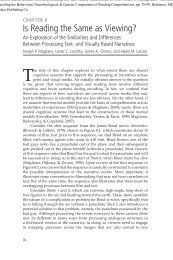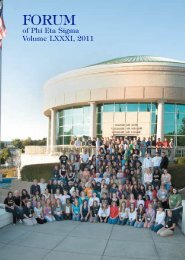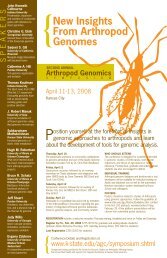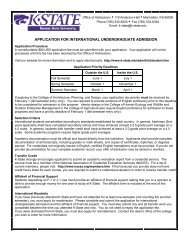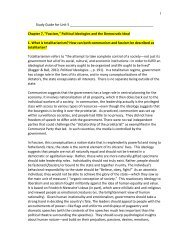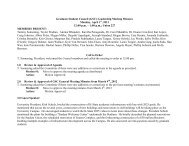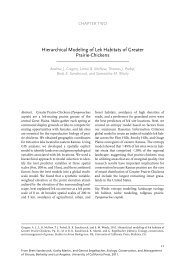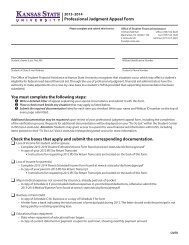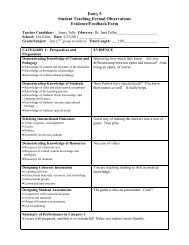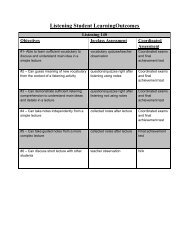Estimation of Demographic Parameters from Live ... - BioOne
Estimation of Demographic Parameters from Live ... - BioOne
Estimation of Demographic Parameters from Live ... - BioOne
You also want an ePaper? Increase the reach of your titles
YUMPU automatically turns print PDFs into web optimized ePapers that Google loves.
nonbreeders (Cam et al. 1998, Sandercock et al. 2000,<br />
Sc<strong>of</strong>ield et al. 2001, Barbraud and Weimerskirch 2005). In<br />
prairie voles (Microtus ochrogaster), adults had higher<br />
apparent survival rates than juveniles, and males had higher<br />
rates <strong>of</strong> maturation than females (Ozgul et al. 2004). If both<br />
age and site are included as states, then multi-strata models<br />
<strong>of</strong>fer age-specific estimates <strong>of</strong> the probability <strong>of</strong> changing<br />
sites (Blums et al. 2003, Lebreton et al. 2003). Social status<br />
and age are sources <strong>of</strong> heterogeneity that would be pooled in<br />
a standard CJS model but can be examined separately in<br />
multi-strata models.<br />
Multi-strata models are particularly flexible for modeling<br />
live-encounter data because investigators can consider a<br />
broad range <strong>of</strong> categorical variables. In addition to the factors<br />
above, studies have used multi-strata models to investigate<br />
covariates describing individual quality: natural or manipulated<br />
clutch size (Viallefont et al. 1995, Doligez et al. 2002),<br />
number <strong>of</strong> breeding attempts (Johannesen et al. 2003), body<br />
mass or fat reserves (Bradshaw et al. 2003, Miller et al. 2003),<br />
social group affiliations (Traylor et al. 2004), and disease<br />
state (Faustino et al. 2004, Senar and Conroy 2004). In the<br />
latter 2 studies, infected individuals (I) had lower apparent<br />
survival rates than uninfected individuals (U), and transition<br />
rates provided estimates <strong>of</strong> disease dynamics (infection: w U I ,<br />
recovery: w I U ). Similarly, Johnson (2005) examined the<br />
spatial dynamics <strong>of</strong> sylvatic plague in black-tailed prairie<br />
dogs (Cynomys ludovicianus) by creating encounter histories<br />
for colonies instead <strong>of</strong> individuals.<br />
At least 3 studies have used variants <strong>of</strong> multi-strata models<br />
to investigate the effects <strong>of</strong> neck collars on arctic-nesting<br />
geese (Alisauskas and Lindberg 2002, Conn et al. 2004,<br />
Reed et al. 2005). A key assumption <strong>of</strong> mark–recapture<br />
methods is that marking techniques have no effect on<br />
subsequent survival, and investigators tested this assumption<br />
by marking geese with either leg bands only (L) or a<br />
combination <strong>of</strong> leg and neckbands (N). In some cases, neckbanded<br />
geese had lower apparent survival or encounter rates,<br />
and multi-strata models provided an estimate <strong>of</strong> the<br />
probability <strong>of</strong> neckband loss (w N L ).<br />
One challenge in multi-strata modeling arises when<br />
observers cannot directly monitor individuals in one or<br />
more strata (Lebreton et al. 2003, Kendall 2004). If<br />
unobservable states are due to temporary emigration, then<br />
multi-strata models provide a useful alternative to robust<br />
design models for estimation <strong>of</strong> breeding propensity (Bailey<br />
et al. 2004a, Schaub et al. 2004). In a multi-strata model,<br />
the 2 states might be coded as O ¼ observable and U ¼<br />
unobservable. The movement parameters <strong>of</strong> a multi-strata<br />
model with an unobservable state are then analogous to the<br />
estimates <strong>of</strong> temporary emigration <strong>from</strong> a nonrandom<br />
robust design model: the probability that an absent<br />
individual remains absent is w U U<br />
t or c9 t<br />
, whereas the<br />
probability that an individual that was present temporarily<br />
emigrates <strong>from</strong> the sampling area is w O U<br />
t or ct<br />
99 (Kendall et<br />
al. 1997, Kendall and Nichols 2002). In the robust design<br />
model, investigators estimate the probability <strong>of</strong> detection for<br />
observable states with closed population models by sampling<br />
in the secondary periods. In multi-strata models, estimation<br />
<strong>of</strong> transition rates for observable and unobservable states is<br />
only possible if investigators impose constraints upon a<br />
subset <strong>of</strong> the parameters to eliminate problems with<br />
parameter identifiability (Fujiwara and Caswell 2002,<br />
Kendall and Nichols 2002).<br />
At least 4 studies have attempted to model unobservable<br />
strata by applying constraints to multi-strata models. In<br />
most studies that have investigated social status with multistrata<br />
models, breeders and nonbreeders are both observable<br />
and the 2 strata are included in the encounter histories. In<br />
North Atlantic right whales (Eubalaena glacialis) and snow<br />
geese, however, nonbreeders are an unobservable segment <strong>of</strong><br />
the population that fail to migrate to breeding areas where<br />
sampling <strong>of</strong> animals occurs (Fujiwara and Caswell 2002,<br />
Reed et al. 2003). In both cases, the authors solved problems<br />
with parameter identifiability by setting apparent survival<br />
rates to be equal for the observable and unobservable strata.<br />
A similar situation arises in studies <strong>of</strong> the demography <strong>of</strong><br />
perennial plants where ramets occur in 3 states: unobservable<br />
rhizomes that are dormant below ground and observable<br />
vegetative and flowering shoots (Shefferson et al. 2003, Kéry<br />
and Gregg 2004). In this case, estimation with multi-strata<br />
models is made possible by fixing the strata-specific<br />
encounter rates (rhizomes: p D ¼ 0, shoots: p V ¼ p F ¼ 1).<br />
By applying constraints to p, it was possible to estimate true<br />
survival and transition rates for all 3 ramet strata even<br />
though investigators did not directly monitor the belowground<br />
life-stage.<br />
Another challenge in multi-strata modeling arises when<br />
observers cannot assign an individual to a categorical state<br />
with certainty (Kendall 2004, Nichols et al. 2004, Senar and<br />
Conroy 2004). Three approaches to dealing with uncertain<br />
strata include: use <strong>of</strong> ancillary information to estimate the<br />
expected frequency <strong>of</strong> different states (e.g., sex ratio;<br />
Sandercock et al. 2005b), discarding all observations or<br />
encounter histories that include uncertain states (Cam et al.<br />
1998), or defining incomplete information as an additional<br />
unknown state (Wood et al. 1998, Conroy et al. 1999,<br />
Faustino et al. 2004). Two studies have used numerical<br />
simulations to explore the effects that removing unknown<br />
observations or including this information as an additional<br />
state has upon the parameter estimates <strong>of</strong> the multi-strata<br />
model (Faustino et al. 2004, Nichols et al. 2004). Apparent<br />
survival was relatively unbiased if unknown observations<br />
were included or removed, transition probabilities (w) were<br />
biased only if unknowns were included, but encounter rates<br />
were biased low in both cases, particularly if the percentage<br />
<strong>of</strong> unknown observations was relatively high (25%).<br />
Kendall et al. (2003) addressed the problem <strong>of</strong> uncertain<br />
strata by combining the multi-strata model with the robust<br />
design model. Observers recorded the breeding status <strong>of</strong><br />
female Florida manatees (Trichechus manatus) during 2<br />
secondary sampling periods nested within each primary<br />
sampling occasion. The combined model controlled for<br />
misclassification errors and estimated the transitional<br />
probability <strong>of</strong> becoming a breeder to be ^/ N B ¼ 0.61,<br />
1512 The Journal <strong>of</strong> Wildlife Management 70(6)



